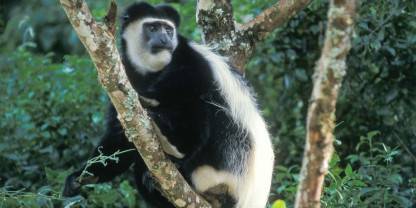Average Expert Rating
Rating Breakdown
Write a User ReviewIsland in the Sky
Home to some famously long-tusked elephants, loads of buffalo, as well as bushbuck and leopards (which are almost never seen), Marsabit National Park is very rarely visited. In fact on my five previous visits I have never seen a single other tourist in the park. A classic driving safari would be rather pointless here as the very dense forest means animal sightings in much of the park are very rare and rather fleeting. But there are at least two large crater lakes surrounded by open marshland and when animals come out of
Read more
the forest to drink they are easily seen at these. I have spent a couple of wonderful evenings, binoculars in hand, watching elephant, buffalo and bushbuck come down for their sundowner drink.Every time I have visited the park the experience has been a little different and your enjoyment of the forest will rather depend on how much rainfall there has been recently. In 2011, during the worst drought in decades, the park was parched, the lakes dry, the leaves fallen from the trees and a fine shroud of dust covered everything. There were virtually no animals present and I really got the impression the park was dying. On a more recent visit, after a year or so of good rain, the park was reborn and compared to the deserts of the surrounding lowlands I felt like I was in the Congolese jungles, so lush and green and healthy did everything appear. So, if you do make the effort of going, try and go in a year when the rains have been favourable.
A Forested Island
Among the most remote and surprising of Kenya’s national parks, Marsabit protects the upper slopes of an isolated massif surrounded on all sides by the arid badlands characteristic of the country’s north. Mount Marsabit is volcanic in origin, and its fertile slopes are swathed in lush tropical forest and studded with ancient calderas, two of which frame permanent crater lakes, while a third holds a seasonal lake. I have often seen elephant and buffalo come to drink at these magnificently scenic lakes. Otherwise wildlife viewing is rather low-key, and the most likely reason you would visit is to break the drive northward to Ethiopia or westward to Lake Turkana, in which case it makes for a wonderfully refreshing stopover. Of interest further afield is a scattering of ‘singing wells’, named for the local Borena custom of singing while several dozen of them form a queue up the steep walls to pass along buckets of water one by one.
An Unlikely Oasis in Kenya’s Inhospitable Northern Frontier
Read more
there worthwhile, although access has improved considerably with the surfacing of the once torturous A2 road north from Isiolo to Marsabit (a distance of 258 km). But the park’s appeal is undoubtedly its relative isolation, forested beauty, and oasis-like character surrounded by stony desert.The Elephants Walking Around the Crater Lake
Marsabit National Park is rarely visited by tourists these days. Once you pass Archer’s Post on the A2 north it feels like you’ve left Kenya behind. You might as well be in southern Ethiopia with its inhospitable but eerily beautiful landscapes and mosaic of cultures. The park protects a forested mountain with three huge crater lakes on the edge of the Chalbi Desert. When I first visited the park more than 10 years ago, I took a picture of a herd of elephants walking along the edge of one of the lakes, a scene I secretly hoped to witness again. And I did on my recent visit… I also saw buffalo, did-diks, bushbuck and lots of birds. The road up here used to be one of the worst in Africa. Now, newly surfaced and lacking traffic, it seems to be one of the best. And with a new lodge opening soon, hopefully this little off-the-beaten-track oasis will attract some adventurous travelers again soon.

